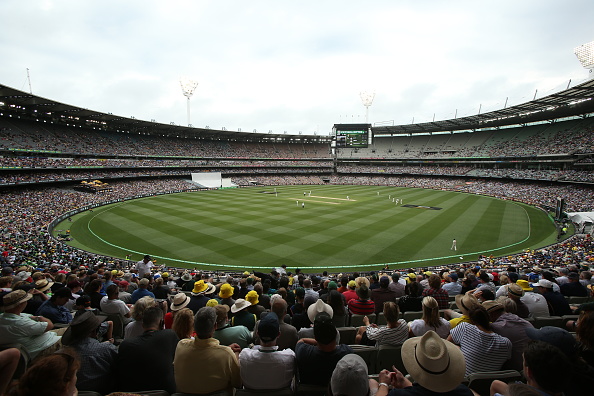Geoff Lemon offers his personal recollections of an iconic Australian cricketing occasion
One of the most fun things about following cricket as an Australian is the quadrennial treat of a home Ashes. Not for the contest, or recently the improved chance of winning, but the joy of watching, reading and hearing English scribes try to adjust to local conditions. Checking the Gabba Press box for snakes, squeezing tomato sauce onto lamington cakes, and, most of all, being completely befuddled by the concept of a hot Christmas.
Australian summer, the thermostat cranking, the shimmer lines on the highways as you drive to your other cousin’s nan’s place in Bendigo or Gundagai. Eking out your day with various terrible uncles deep in the pancake plain of an infinite suburban sprawl. The image is always of heat, bare survival.
Sure, we’re still jarringly stuffing our faces with hot roast meat and veggies, but we’re also shifting buckets of chilled prawns, mango chunks, fresh oysters, peaches and nectarines. Frutti del mare and fruits of the land, sent down from Mildura by the hands of a thousand backpackers. Frosty beers and sparkling wine – we make our own now, Champagne province can keep its own.
It was all about heat when the comedian John Clarke rewrote Dylan Thomas, relocating A Child’s Christmas In Wales to the Victorian coastal town of Warrnambool. Of course, it’s not always hot in that southern state, my home. There was the year it snowed, morning flowerbeds thick with ice. There was the year a tropical-strength deluge saw us digging a trench across the back lawn in the middle of Christmas dinner, returning drenched for dessert.
But it’s a story of heat because it’s a story of warmth. A story of openness. That’s how Melbourne feels leading up to Christmas, as you ride the quiet back streets and hear parties, see decorations, dodge groups of cheerful idiots stumbling between venues. It’s infectious.
In a backward turn of events, I was on my way to a Long Island Iced Tea party rather than on my way home from one when the bike rebelled and broke my wrist, but I went to the party before casualty. The season demands it.
Even the Royal Melbourne Hospital is festive on Christmas Eve. The cathedrals have their doors open and candles lit. The Retreat in Brunswick is the beer garden where Tinkerbell would live if she was an alcoholic: the massive old tree in its courtyard has boughs spread far and wide, fairy lights twisted along the length of each. Under its embrace you feel home and safe.
Across the street, when you emerge from midnight mass at Christ’s Church on Glenlyon Road, hearing the sounds of conviviality spilling through the branches over the pub’s corrugated-tin fencing, the two gatherings don’t seem very far apart at all.
Then fleetingly it passes, and Boxing Day arrives. Twenty years of getting up with Dad, driving down from the country or catching the Hurstbridge line, being heavied by ticket inspectors or fleeced by parking attendants, always among the first to purge the seasonal spirit from their veins like a toxin born of gluttonous indulgence.
There’s the walk down, alongside the Fitzroy Gardens, past the interpretive-dance police waving at the intersection, through Yarra Park to an MCG that is both colossus and island.
It dominates Melbourne’s skyline, rules its aspect, but is nowhere near anything. Long walks in each direction: through the park and Punt Road to the pubs of Richmond, to that lone hotel lost in wealthy East Melbourne suburbia, to the untenanted stretches of Wellington Parade.
Southward lies the clustered mess of tracks that spill from the mouth of Flinders Station, the walkovers, the tennis centre, the stadium for rectangle-sport, the training grounds, bike paths, tunnelled on-ramps, the river, the traffic bridges, then the Botanic Gardens, the Punt Road hill and South Yarra mansions and Melbourne Girls Grammar.
Not until Domain St in the south do you re-encounter public amenities and welcoming doors; not until Collins and Spring Streets to the west; until the Corner Hotel on Swan St to the southeast, or the Bridge Road hill at the northeast corner; or straight north on the long strike through the gardens until at last the ventricles of Smith and Brunswick Streets empty into the artery of Victoria Parade.
All alone, in the middle of all of that, sits this one ground, just as Boxing Day Test sits inviolable in the midst of the holiday season’s most frenetic blurting.
Of course, the match doesn’t always live up to the billing. Maybe it rarely does. I can’t remember the last time we had a close one. We’re often lucky to have an uninterrupted one. Walloping the West Indies is better than losing to England, but not by much. Losing to England should be preferable to watching rain, but it isn’t. Watching rain is what we often end up doing – one of the things about summer heat is that it brings summer precipitation.
And so it has been this year, with near on 60,000 people watching half a day’s play on the 26th. Watching Azhar Ali dutifully occupy the crease. Perhaps not a prospect to set the blood racing, but it had to be admired. There was Christmas heat aimed at him, and he withstood it.
Time and again, delay to delay, across three days, to end up undefeated with a double-century to his name. A study in resilience and perseverance.
That is all that any of us can offer, and that is what the observation of tradition is about. The blind pursuit of that ideal is one of our most destructive tendencies, but at its best tradition also delivers these moments of beauty.
Even in the humid rain, Boxing Day in Melbourne offers that. Next time, it’s England’s turn again. See you there.
This piece originally featured in The Cricket Paper, December 30 2016
Subscribe to the digital edition of The Cricket Paper here












